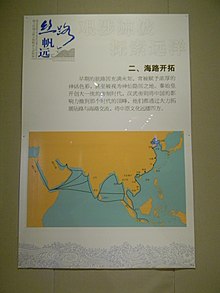
Back Θαλάσσιος δρόμος του μεταξιού Greek Ruta marítima de la seda Spanish Jalur Sutra Maritim ID 海のシルクロード Japanese മാരിടൈം സിൽക്ക് റോഡ് Malayalam Морской шёлковый путь Russian 海上丝绸之路 Chinese 海上絲綢之路 ZH-YUE

The Maritime Silk Road or Maritime Silk Route[1] is the maritime section of the historic Silk Road that connected China, Southeast Asia, the Indian subcontinent, the Arabian Peninsula, Somalia, Egypt and Europe. It began by the 2nd century BCE and flourished later on until the 15th century CE.[2] Major players in the Maritime Silk Road include the merchants from the Tang, Song, Yuan and Ming dynasties of imperial China,[3] Austronesian sailors in Southeast Asia,[4]: 11 Tamil merchants in India and Southeast Asia,[4]: 13 and Persian and Arab traders in the Arabian Sea and beyond.[4]: 13 The network followed the footsteps of older maritime networks in Southeast Asia,[5][6][7][8] as well as the maritime spice networks of Southeast Asia, Sri Lanka, India, and the Indian Ocean, coinciding with these ancient maritime trade roads by the current era.[9][10]
- ^ Wang, Qiang (2020). Legendary Port of the Maritime Silk Routes: Zayton (Quanzhou). Qiang Wang. p. 280. ISBN 978-1-4331-7040-9.
- ^ "Maritime Silk Road". SEAArch.
- ^ Franck Billé; Sanjyot Mehendale; James W. Lankton, eds. (2022). The Maritime Silk Road (PDF). Amsterdam University Press. ISBN 978-90-4855-242-9.
- ^ a b c Cite error: The named reference
Guanwas invoked but never defined (see the help page). - ^ Tsang, Cheng-hwa (2000). "Recent advances in the Iron Age archaeology of Taiwan". Bulletin of the Indo-Pacific Prehistory Association. 20: 153–158. doi:10.7152/bippa.v20i0.11751 (inactive 2024-04-12). ISSN 1835-1794.
{{cite journal}}: CS1 maint: DOI inactive as of April 2024 (link) - ^ Turton, M. (17 May 2021). "Notes from central Taiwan: Our brother to the south". Taipei Times. Retrieved 24 December 2021.
- ^ Everington, K. (6 September 2017). "Birthplace of Austronesians is Taiwan, capital was Taitung: Scholar". Taiwan News. Retrieved 24 December 2021.
- ^ Bellwood, Peter; Hung, H.; Lizuka, Yoshiyuki (2011). "Taiwan Jade in the Philippines: 3,000 Years of Trade and Long-distance Interaction". In Benitez-Johannot, P. (ed.). Paths of Origins: The Austronesian Heritage in the Collections of the National Museum of the Philippines, the Museum Nasional Indonesia, and the Netherlands Rijksmuseum voor Volkenkunde. ArtPostAsia. ISBN 978-971-94292-0-3.
- ^ Bellina, Bérénice (2014). "Southeast Asia and the Early Maritime Silk Road". In Guy, John (ed.). Lost Kingdoms of Early Southeast Asia: Hindu-Buddhist Sculpture 5th to 8th century. Yale University Press. pp. 22–25. ISBN 9781588395245.
- ^ Mahdi, Waruno (1999). "The Dispersal of Austronesian boat forms in the Indian Ocean". In Blench, Roger; Spriggs, Matthew (eds.). Archaeology and Language III: Artefacts languages, and texts. One World Archaeology. Vol. 34. Routledge. pp. 144–179. ISBN 978-0415100540.
© MMXXIII Rich X Search. We shall prevail. All rights reserved. Rich X Search